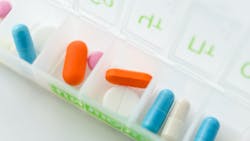HHS announces prescription drug payment model that will find the lowest price charged
The Department of Health and Human Services (HHS) Secretary Alex Azar announced a drug payment model through the Center for Medicare and Medicaid Innovation at the Centers for Medicare & Medicaid Services (CMS) that will lower Medicare Part B payments for certain drugs to the lowest price for similar countries and save American taxpayers and beneficiaries more than $85 billion over seven years.
Starting in January, the model, known as the Most Favored Nation (MFN) Model, will test an innovative way for Medicare to pay no more for high cost, physician-administered Medicare Part B drugs than the lowest price charged in other similar countries. The MFN Model will protect current beneficiary access to Medicare Part B drugs, make them more affordable, and address the disparity of drug costs between the U.S. and other countries.
Over the last five years, Medicare Part B percent drug costs have grown at an annual rate of 11.5 percent. The 2020 Medicare Trustees report noted that Medicare Part B drugs have consistently been a major contributor to overall Medicare Part B spending trends, accounting for 37 percent of the change in Medicare Fee-for-Service Part B benefit spending from 2015 to 2019. Medicare Part B drug spending of $30 billion in 2019 made up 14 percent of total Medicare Fee-for-Service Part B spending, up from 11 percent in 2015.
Medicare Part B drug spending is growing faster than drug spending in Medicare Part D and the U.S. as a whole. In a new report released today, the HHS Office of the Assistant Secretary for Planning and Evaluation (ASPE) found that between 2006 and 2017, Medicare Part B Fee-For-Service drug spending per enrollee grew at 8.1 percent, more than twice as high as per capita spending on Medicare Part D (3.4 percent) and nearly three times as high as overall retail prescription per capita drug spending (2.9 percent). Moreover, spending and enrollment projections by the CMS Office of the Actuary for the 2021 President’s Budget suggest that per capita spending on Medicare Part B physician-administered drugs and separately payable hospital outpatient drugs will grow at a similar annual rate of 8 percent between 2020 and 2027, before consideration of any COVID-19 pandemic impacts.
While state Medicaid programs and Medicare Advantage plans have tools to reduce certain drug costs through price negotiations, current law requires the Medicare Part B program to pay for most drugs administered by physicians at the average sales price in the United States, plus a percentage-based add-on payment. As manufacturers largely have the ability to set these prices independent of market forces, the result is that Americans pay more than twice as much as individuals in other higher-income countries for Medicare Part B drugs, according to a new ASPE study. This anti-competitive system leaves taxpayers and American seniors on the hook for paying the highest drug costs in the world.
For example, the top-selling Part B drug—a common eye drug (Eylea)—was approximately two times as expensive in Medicare Part B as in comparison countries. Because many seniors pay their 20 percent coinsurance obligation out of pocket, this difference costs them thousands of dollars in additional medical expenses a year. These high costs have a real impact: Medicare beneficiaries are often on fixed incomes and paying more for these drugs can hurt them financially, prompt them to take fewer doses of their medications, or lead them to abandon treatment altogether.
The Most Favored Nation Model will operate for seven years. Under the model, CMS will test paying based on the MFN Price for 50 Medicare Part B drugs and biologicals with the highest Medicare Part B spending. These 50 drugs and biologicals encompass approximately 73 percent of Medicare Part B drug spending, despite accounting for fewer than 10 percent of Medicare Part B drugs. All Medicare-participating physicians, hospitals and ambulatory surgical centers in the United States and territories will be paid the model payment for these 50 drugs and biologicals, rather than the current average sales price plus six percent add-on. The model payment will include two parts: a drug payment amount that will phase in the lowest price in other similar countries by blending it with the average sales price, and a flat add-on amount per dose that will be the same for each model drug. The model will accelerate the phase-in of the MFN Price if drug manufacturers increase U.S. prices faster than inflation and the lowest price in other similar countries. The model’s flat per-dose add-on will remove the incentive for participating physicians, hospitals and other providers to furnish high-cost drugs. Beneficiaries’ cost sharing on this add-on payment will be waived.
The model also includes protections for beneficiaries to ensure they will see savings compared to what they would pay if the model were not tested. Additionally, the model includes financial hardship protections for certain MFN participants (physicians, hospitals, and other providers) whose revenue is significantly affected by the model.
